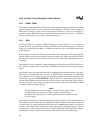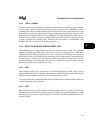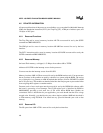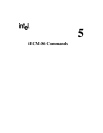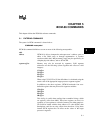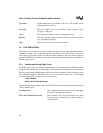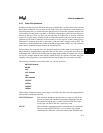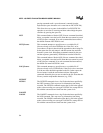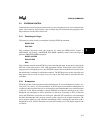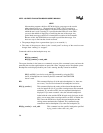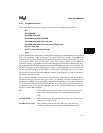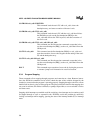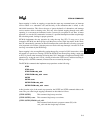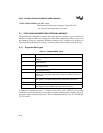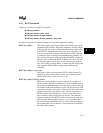
INTEL 186 EB/EC EVALUATION BOARD USER’S MANUAL
5-4
parsing commands until a space character is entered from the
keyboard (the space character can’t come from an INCLUDE file).
This allows the user to pause in the middle of an INCLUDE file
operation to see what is occurring and then acknowledge the pause
condition by pressing the space bar.
LIST This command behaves like the LIST filename command described
below, except that it uses the last file name that was entered as part of
a LIST filename command. If no such command has been entered,
the default filename LIST.ECM is used.
LIST filename This command attempts to open filename as a writable file. If
filename already exists, then iECM-86 asks if the file is to be
overwritten or if the new data should be appended to the existing file.
It then opens the file and stamps it with the current date and time
from the system clock. Subsequent commands entered by the user
and the responses generated by iECM-86 are recorded in the file.
LOG This command behaves like the LOG filename command described
below, except that it uses the last file name that was entered as part of
a LOG filename command. If no such command has been entered,
the default file name LOG.ECM is used.
LOG filename This command attempts to open filename as a writable file. If
filename already exists, iECM-86 asks if the file is to be overwritten
or if the new data should be appended to the file. It then opens the
file and stamps it with the current date and time. Subsequent
commands entered by the user are recorded in the file. Note that this
file may contain nonprintable characters (e.g., ESC).
LISTOFF
LISTON The LISTOFF command closes a list file that has been specified by
the LIST command. This stops new list information from being
recorded. The LISTON command reopens the list file in the append
mode so that recording can start again. LISTON also stamps the list
file with the current date and time from the system clock.
LOGOFF
LOGON The LOGOFF command closes a log file that has been specified by
the LOG command. This stops new log information from being
recorded. The LOGON command reopens the log file in the append
mode so that recording can start again. LOGON also stamps the list
file with the current date and time from the system clock.



